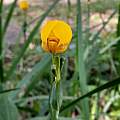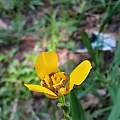Trimezia Salisb. ex Herb. is a genus in the Iridaceae family of subtropical and tropical America (Central, South America, West Indies, and Florida). In 2025 it also includes the genera Neomarica, Pseuiris, and Pseudotrimezia. Common names for many of the species are walking iris, apostle's iris and apostle plant. Plants are evergreen or seasonal perennials that grow from either an erect rhizome or a corm and have iris-like fans of leaves and short-lived flowers not unlike Cypella with three larger outer segments and three small inner ones. Most are summer growers with a rest period in winter. Species probably need the protection of a greenhouse in winter and should not be allowed to dry out completely during this time.
Trimezia candida (Hassl.) Ravenna syn. Neomarica candida (Hassl.) Sprague grows in the forest in the region of Blumenau, Santa Catarina State, southern Brazil. Height range: 45-90 cm. Photos by Tarcísio Eduardo Raduenz.
Trimezia coerulea (G.Lodd.) Ravenna syn. Neomarica caerulea (Ker Gawl.) Sprague is native to Brazil, a large evergreen plant with bright sky-blue or bluish-lilac short-lived flowers. Given warm conditions and regular water, it is long blooming. If grown in a pot, it needs a very deep one and protection from snails. It grows in full sun or shade. Height range: 2-4 ft. Photos 1-2 from Tarcísio Eduardo Raduenz, photos 3-4 from Pieter van der Walt, and photo 5 from Andrew Harvie.
Trimezia gracilis (Herb.) Christenh. & Byng syn. Neomarica gracilis (Herb.) Sprague is from Mexico and Costa Rica south to Brazil. This species is sometimes called the "walking iris" but this name may also be used for some of the other species. It has short-lived ivory flowers with reddish-brown transverse bars on the claw. The inner segments are blue, smaller with reflexed tips.. It blooms in summer and appreciates shade. It has leaves with prominent veins and a stem that is forked below the apex. It is distinguished from other white flowered species, bearing its flowers on long (gracile) peduncles (the stems connecting the whole flowering business to the scape) and pedicels (the individual flower stems), many times longer than the enveloping bract. Height: to about 60 cm. Photo by Andrew Harvie.
Trimezia longifolia (Link & Otto) Christenh. & Byng, syn. Neomarica longifolia (Link & Otto) Sprague, is a species growing to 1 meter from southeastern Brazil where it grows in light shade in the Atlantic Forest. According to Clive Innes' book leaves are bluish-green, flat, leathery, broad and up to 30 cm. The stems are erect, stiff, and wiry. The 5 cm flowers are lemon yellow. The outer segments have transverse bars of purplish brown on the claw and the inner segments have brownish or beige tips. Most of the plants people are growing under this name are really Trimezia steyermarkii. For a photo of this species, see Mauro Peixoto's web site.
Trimezia martinicensis (Jacq.) Herb. is a species originally from Central and South America and the West Indies that is widely naturalized through the tropics. It is closely related to Trimezia steyermarkii with which it has been widely confused. It has yellow to golden flowers that are marked bronze at the base unlike Trimezia steyermarkii which has brownish-purple bands. It also opens less widely and has tepals that are folded inwards. According to the description from Clive Innes' book plants grow from 20 to 40 cm. Leaves are narrow, flattened, slender, to about 30 cm. The stems are erect, terete, glabrous. Several short-lived flowers are produced in succession. Most of the plants grown under this name are really Trimezia steyermarkii. Photos from iNaturalist were taken by Julien Piolain in French Guiana and shared under a CC BY-NC license.
Trimezia northiana (Schneev.) Ravenna syn. Neomarica northiana (Schneev.) Sprague is from Brazil and has white flowers that become yellowish with brown markings at the base. Inner segments are recurved and marked bluish-purple. Leaves are fan-like, and flat. The stem is flattened and continues above the inflorescence as a leaf-like bract. Young plants form at the tip, bending over and rooting, giving it a common name of Walking Iris. It is easily confused with Trimezia candida, which is only half the size (40-80 cm) and whose tepals are not yellowish at the base. Height range: 2-3 ft. Photos 1-3 by David Ehrlich of plant obtained from Yucca-Do. Photo 4 from Andrew Harvie.
Photos of this plant that was formerly considered to be a Neomarica species were taken by Tarcísio Eduardo Raduenz. He wrote: "Although the flowers on this plant resemble T. coerulea, the fruits are different. The fruit of Trimezia coerulea and Trimezia candida open longitudinally when mature. The fruit of Trimezia sp. opens only in the superior extremity."
Trimezia sp., syn. Neomarica guttata, was described by Capellari as a new species that grows from 30 to 50 cm and is localized to the city of Itanhaem, Brazil. It grows in the shade, receiving only a few hours of diffuse sunlight each day. The flower is distinctive in having lilac dots on the white sepals. This name does not yet (2025) appear in any of the major data bases or IPNI as a published name. It appears to be cultivated by a number of individuals. Photo by Alessandro Marinello.
Trimezia steyermarkii R.C.Foster was identified by Alberto Castillo in the first photo as the plant blooming for Lee Poulsen in September 2003 in a pot without a label. Alberto states it is a well known Caribbean plant widely used in landscaping in the New World tropics and frequently misidentified as Trimezia longifolia or Trimezia martinicensis. Clive Innes' book describes it as having leaves that are ensiform, thin textured with a prominent mid-rib and yellow flowers with purple and brownish-purple bands. Photos 2-4 from Mary Sue Ittner who notes that individual flowers are very short lived (part of a day), but blooming continues over a long period. Photo 2 shows the plant, photo 3 the open flower, and photo 4 the flower from the side. The fifth photo was taken by Andrew Harvie. The last photo was taken by Dennis Kramb. Height range: 30-60 cm.


























